All About the Crowns, Swords and Other Historic Artifacts Being Used at King Charles' Coronation
Historic Royal Palaces historian Charles Farris gives PEOPLE a glittering guide on what's coming out of the royal vault for coronation of King Charles and Queen Camilla on May 6
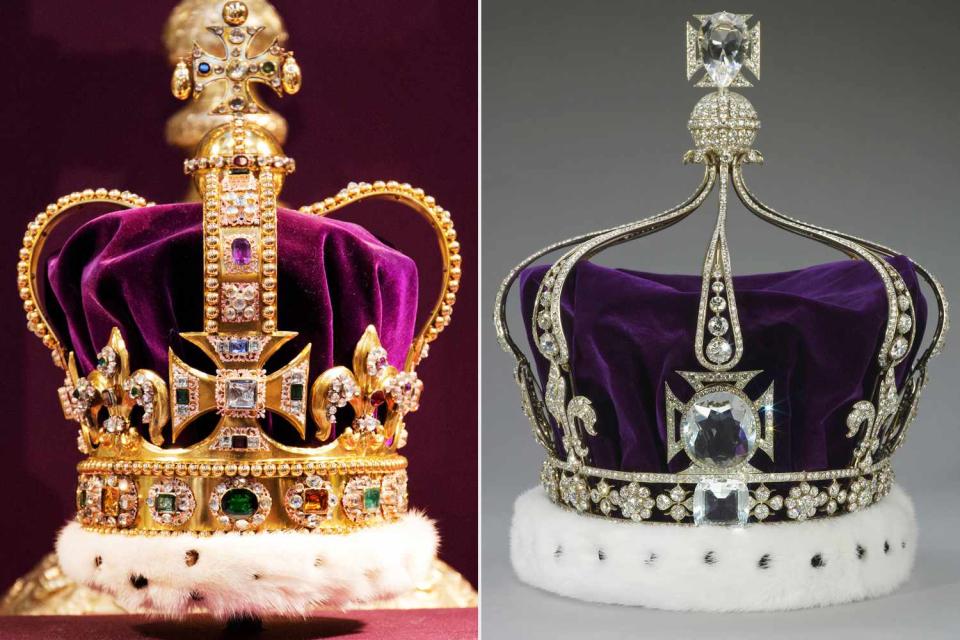
Coronation Countdown
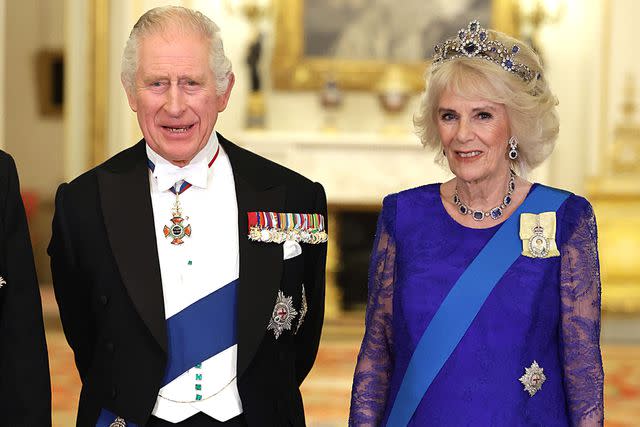
When King Charles is crowned on May 6, he will be bedecked in some of the most significant regalia in royal history.
The St. Edward's Crown, special anointing spoon and ceremonial swords are among the precious objects that underscore Britain's long monarchical history, and the traditions that underpin it.
Charles Farris, public historian at Historic Royal Palaces and curator of an upcoming Tower of London exhibit starring some of the incredible gems exclusively tells PEOPLE some symbols can be traced back to King Edgar's coronation in 973, the first recorded in detail. With "anointing and investiture and blessings and processions," Farris says, "in that way coronations remain largely unchanged adapt and change."
Today, some of the jewels come from different reigns and reflect "tradition and history" with their embellishment in the current crowns and other regalia, Farris says.
"There is an important cultural and historical thread that goes through all of these jewels, and it is part of the continuing cultural historical significance of the collection," the curator tells PEOPLE.
St. Edward's Crown
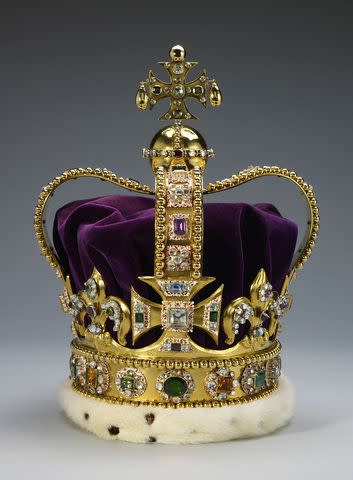
Weighing nearly 5 lbs., the magnificent crown was created in 1661 from a solid gold frame, set with semi-precious stones from tourmalines, topazes, rubies, sapphires, zircons and aquamarines. Four crosses and four fleurs-de-lis decorate the gold band.
"It is a very heavy, impressive, beautiful object," says Farris. St. Edward's crown is considered the most sacred in the royal collection and is only used for the actual crowning, per Historic Royal Palaces.
It was commissioned for the coronation of King Charles II, the first sovereign following the English Civil Wars in the 17th century, and modeled on the previous crown that had been destroyed by the Parliamentarians. Like the original, it is named for St. Edward the Confessor, an Anglo-Saxon king who died in 1066.
"It was said that his crown was used in coronations — the first one we have a record of is Henry III in 1220 and it was historically kept at Westminster Abbey," Farris adds.
Imperial State Crown
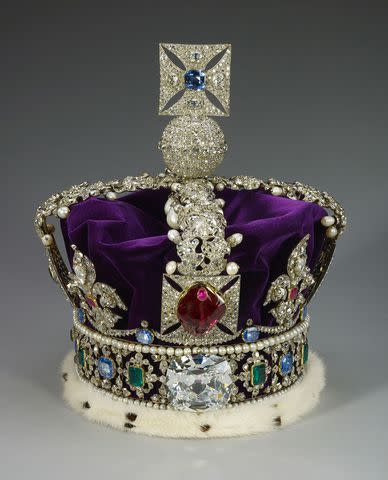
The highly recognizable crown is traditionally worn at state ceremonies like the State Opening of Parliament. The King is expected to change into it after the crowning with St. Edward's Crown, as his mother Queen Elizabeth did at her coronation in 1953.
"State crowns are worn more frequently, and sometimes need to be repaired. Also, tastes change and different ones have been ordered over time. Queen Victoria's was repaired several times, and that was replaced with the current one made in 1937," Farris tells PEOPLE, but it "contains many historic jewels which have histories of their own."
Chief among those is Cullinan II diamond set in the band. Weighing a whopping 317.4 carats, "It is only the second-largest stone cut from the original Cullinan diamond which was 3,106 carats when it was found," the historian says.
The gem was given to King Edward VII by the South African Transvaal Colony in 1907, and the complicated history will be explored in the new exhibit at the Tower of London.
Sovereign Sceptre with Cross

A gold rod topped by a gilded heart shape that encloses the Cullinan I diamond – the first of nine pieces cut from the original to be used in the Crown Jewels — and is counted at 530.2 carats. The glittering atop represents royal power and royal justice.
Elsewhere in the crowning ceremony, King Charles will be presented with a sceptre topped with a dove representing with fairness and mercy. The dove represents the Holy Spirit, reminding both he and the congregation of the ceremony's religious nature.
Regal Detail
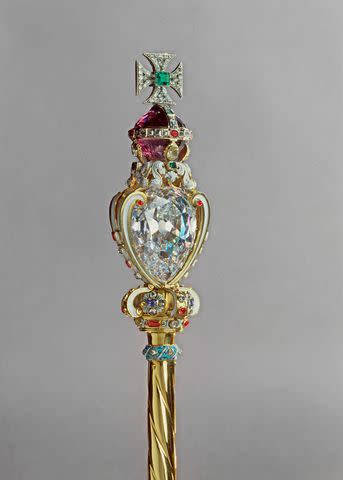
"If you think back to the medieval origins of the ceremony you see this was a very gestural process. A lot of people who would have been at those medieval ceremonies wouldn't necessarily been able to understand what was going on [because] they were in Latin," Farris tells PEOPLE of ancient coronations.
Therefore, sceptres and crowns visually served as "very clear indications of what the ceremony was, even if you didn't understand it."
The Sovereign's Orb
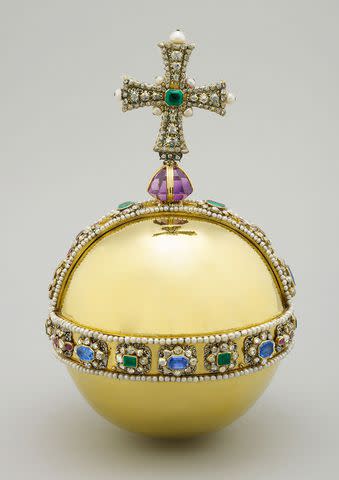
Another piece made for King Charles II in 1661, the orb is an ancient symbol of power, representing the Earth. In the medieval period, Ferris says, a cross was added.
"The message is that God reigns over the earth and reminds the monarch of the source of their power. Orbs and cross are repeated on crowns as well," he says. "This is an ancient Christian ceremony, and since the early modern period the monarch has also been Defender of the Faith and Head of the Church of England."
Cecil Beaton's iconic coronation portrait of Queen Elizabeth shows her cradling the Orb and holding the Sceptre.
Ceremonial Maces
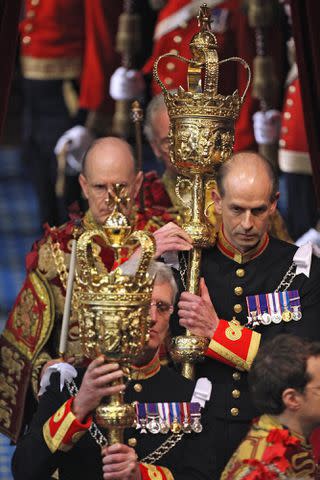
Two Maces, made of silver gilt over oak, and dating between 1660 and 1695, are brought into Westminster Abbey in a procession at the beginning of the service. These ceremonial are carried before the sovereign for special occasions like the State Opening of Parliament (pictured).
Sword of Temporal Justice
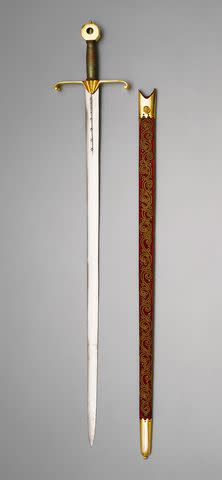
Also carried in before the ceremony are three swords, brought in unsheathed aloft without their scabbards, points up.
"They symbolize knighthood and knightly virtues and values and the need to protect those in need," Farris explains.
The Sword of Sword of Temporal Justice (pictured) signifies the Monarch's role as Head of the Armed Forces.
Sword of Spiritual Justice
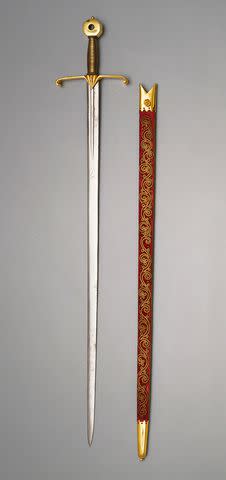
The Sword of Spiritual Justice represents the monarch as Defender of the Faith.
Sword of Mercy
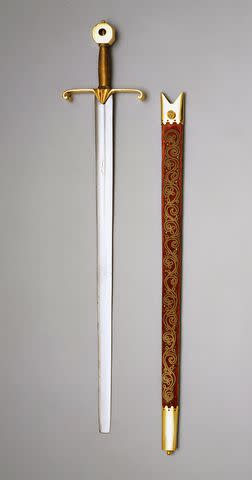
The Sword of Mercy, or Curtana, uniquely has a blunt tip to symbolize the monarch's mercy.
Ampulla
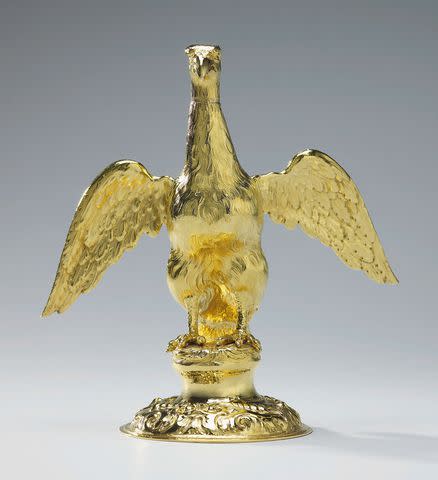
The most sacred part of the coronation service is the anointing. Associated with kingship that goes back to the Old Testament, English monarchs have been anointed with holy oil for more than a thousand years.
The Chrism oil for King Charles and Queen Camilla's coronation was consecrated in Jerusalem in March, and will be contained in the gold Ampulla on the big day, the oil will pour through the eagle's beak.
Coronation Spoon
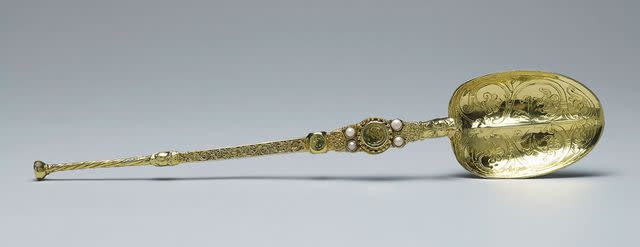
During the anointing, the Chrism oil will be poured onto the coronation spoon — the oldest surviving piece of coronation regalia! — and the Archbishop of Canterbury will dip his finger into the oil and anoint King Charles on his head, chest and hands.
"All this happens in secret under a golden canopy," says Farris of the solemn moment.
Seventy years ago, the moment of anointing at Queen Elizabeth's coronation was considered so sacred that cameras were not allowed to capture it, the BBC reported.
Queen Mary's Crown
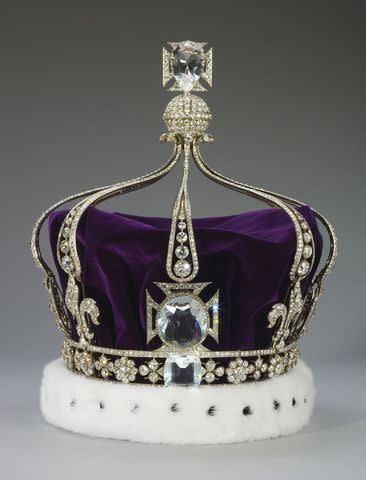
The spectacular headpiece was made for Queen Mary for the coronation of her husband, King George V, in 1911, and Queen Camilla will take it out of the archives for the upcoming crowning ceremony. The royal rewear will mark the first time in recent history that an existing crown will be used for the coronation of a Queen Consort instead of a new commission being made, Buckingham Palace said, "in the interests of sustainability and efficiency."
In a touching tribute, Queen Mary's Crown will be slightly tweaked to feature the Cullinan III, IV and V diamonds that were part of Queen Elizabeth's personal jewelry collection. The late monarch often wore them as brooches.
For more People news, make sure to sign up for our newsletter!
Read the original article on People.

 Yahoo News
Yahoo News 
